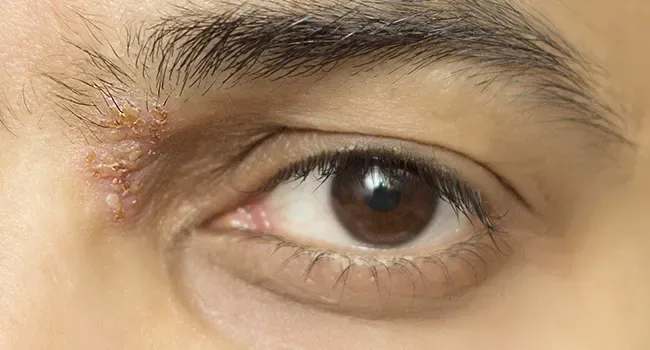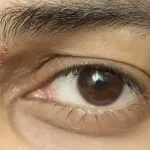It can be unpleasant and uncomfortable to experience shingles anywhere on your body. However, the risk to your health from acquiring shingles in your eye may be one of the worst experiences. Shingles in the eye region can impair eyesight in addition to pain and other possible signs and symptoms of the infection. Consult your doctor for possible treatments if you are experiencing any symptoms.
You are more likely to develop shingles if you are older than 50 years of age. Knowing the warning signs and symptoms of eye shingles can help you get better more quickly and prevent the condition altogether.
Let us understand what shingles in the eye are?
The varicella-zoster virus, which is also responsible for chickenpox, causes shingles. After your body recovers from the illness associated with chickenpox, the virus enters a dormant phase. That does not, however, imply that it is permanently lost. Years later, the same varicella-zoster virus might reappear and cause shingles, most frequently on the body’s trunk. Herpes zoster ophthalmicus is the name for it when it affects the area around the eyes. Ocular shingles is another name for herpes zoster ophthalmicus (HZO). It is known as herpes zoster keratitis when it affects the cornea. There is rash in and around the eye area in 10-20% of shingles patients. Shingles in the eye may affect the nerves in and around the ocular region. The area affected by this nerve injury may experience extreme pain and malfunction.
Shingles in the eye symptoms
A bigger risk exists if you have shingles in your eye since it can persist and impair your vision. The symptoms of shingles usually affect one side of the body, no matter where they start. Because of this, the virus is unlikely to travel to the other side of your face, opposite to where you have a severe rash in or around one eye.
The following are some signs and symptoms of eye shingles –
- Permanent eyesight impairment
- Headache
- Tearing, irritation, and redness in the eyes
- Blurred vision
- Nausea
- Strong stinging, burning, and throbbing in and around the eye
- Upper eyelid blisters that filled with fluid that are painful
- Inability to move the eye
- The exceptionally sensitive skin around the afflicted eye
Causes of shingles in the eye
The same virus that causes chickenpox also causes shingles, known as varicella-zoster. Shingles can appear in anyone who has suffered from chickenpox. The virus persists in your body and may reappear as shingles years later, resulting in pain and a rash on your skin. A person cannot get shingles if they never had chickenpox or been exposed to the virus.
The shingles virus may not always become active in those who have had chickenpox. When it does, the back, ribs, and chest are where the shingles rash typically develops. Sometimes it will appear in other places, such as the face or legs.
Experts claim that increased shingle instances result from weakening of immune systems and stress. Since the virus can spread throughout your body and manifest in different locations, it is impossible to anticipate whether you will develop ocular shingles.
How are Shingles in the eye treated?
If anyone sees any symptoms for shingles, they should immediately consult an optometrist, as well as their regular care physician. Treating shingles in the eye is necessary as it can cause vision loss and other serious issues.
A physician will first perform a physical examination and interview you about your symptoms to determine if you have shingles in your eye. Typically, they’ll use tools like an ophthalmoscope and a slit lamp to examine the eye. This will enable them to recognize both the external and internal clinical symptoms of the illness.
Some experts also recommend antiviral medicines like acyclovir, famciclovir, and valacyclovir. Once you become aware of your symptoms, start taking the antiviral medication directed by your doctor for immediate benefits. Most patients who get prompt treatment fully recover from shingles.
Shingles in the eye can be treated in different ways. If your doctor determines that your eyes are involved, you might also require topical eye drops. Topical eye drops for shingles typically fall into one of two categories:
- Corticosteroid eye drops:
Steroid eye drops can lessen shingles-related ocular irritation. As a result, there are fewer chances of ocular shingles problems.
- Pupil-dilating eye drops:
Your doctor could also recommend eye drops to keep your pupils open so you can get some pain relief from the shingles-related internal ocular inflammation.
How to prevent shingles in the eye?
Handling shingles has two components: preventing them from developing in the first place or treating them when they arise. Shingles cannot be contracted without first experiencing chickenpox. You should therefore immunize everybody who hasn’t already had varicella-zoster, including kids and adults. Receiving the shingles vaccine is a good way to prevent shingles. Herpes zoster can be prevented from re-emerging with the help of vaccination, according to research. When it happens, the symptoms are often not as severe.
If you have shingles, stay away from other individuals, particularly if they haven’t had chickenpox, are pregnant, or have a weak immune system. Avoid touching your eye and cover your rash to prevent the infection from spreading. Even though touching other areas of your body after touching the rash won’t always cause it to spread, you should still take all necessary precautions to keep it contained.
Why CFS?
The eye specialists at CFS provide top-notch vision correction, with a focus on LASIK, cataract, cornea, retina, and glaucoma therapies. You can expect cutting-edge medical facilities at CFS that pair revolutionary technology with the most skilled ophthalmic staff. Although having shingles can be stressful, you can be assured that CFS will provide excellent care. We aim to support you and provide the best treatment for all kinds of eye ailments.
Article: Shingles In The Eye – Symptoms, Causes, Treatment, And Prevention!
Author: CFS Editorial Team | Oct 15 2022 | UPDATED 03:05 IST
*The views expressed here are solely those of the author in his private capacity and do not in any way represent the views of Centre for Sight.





